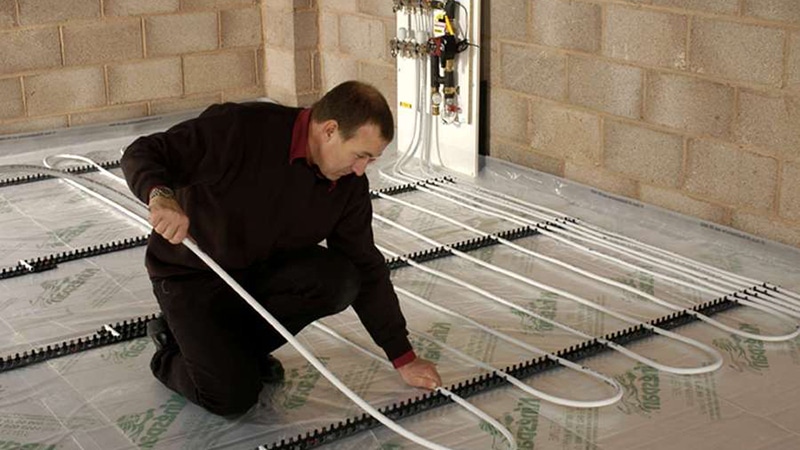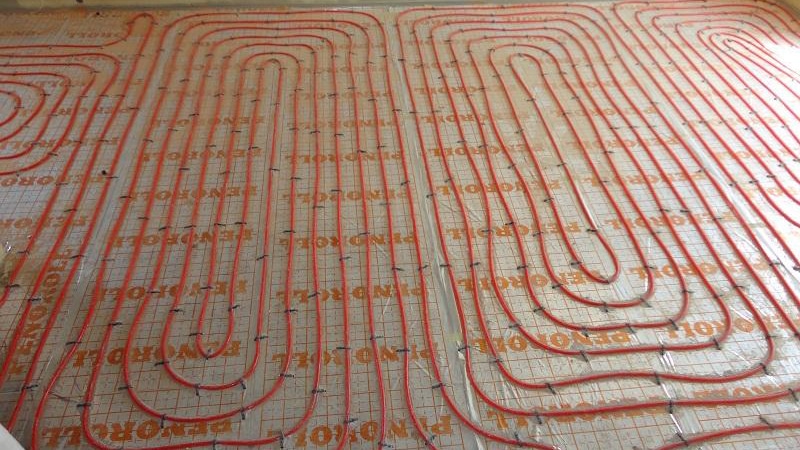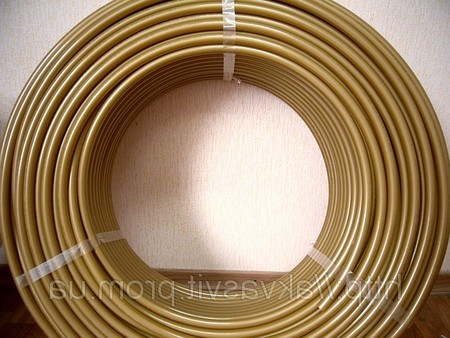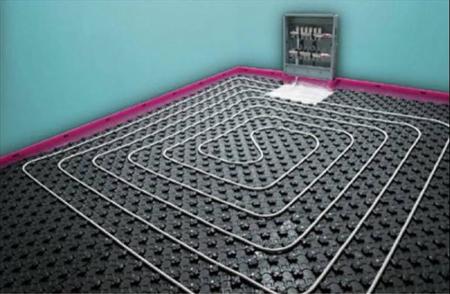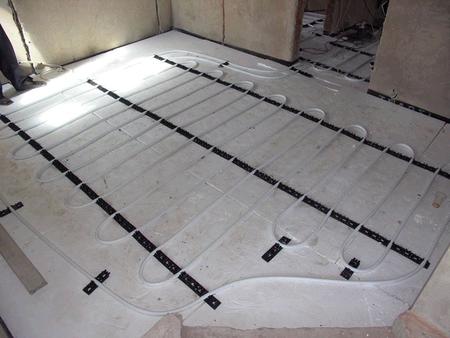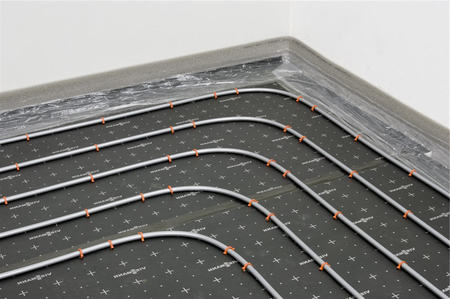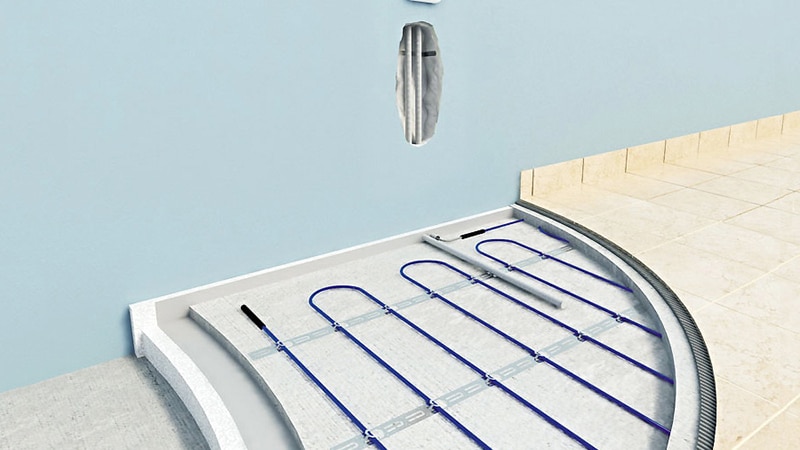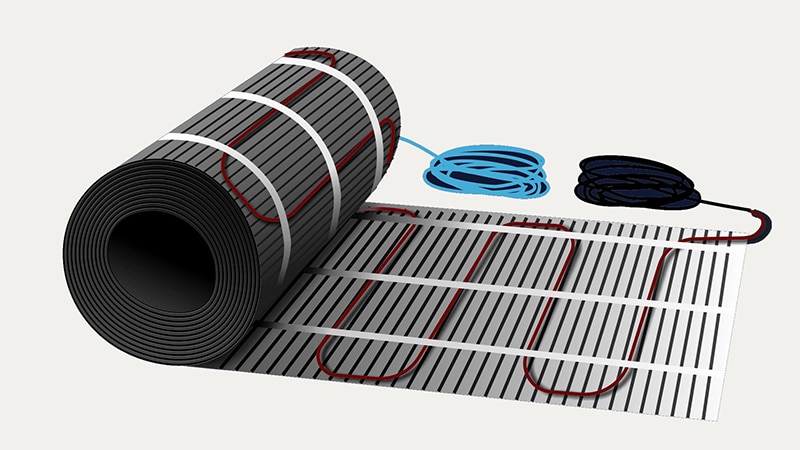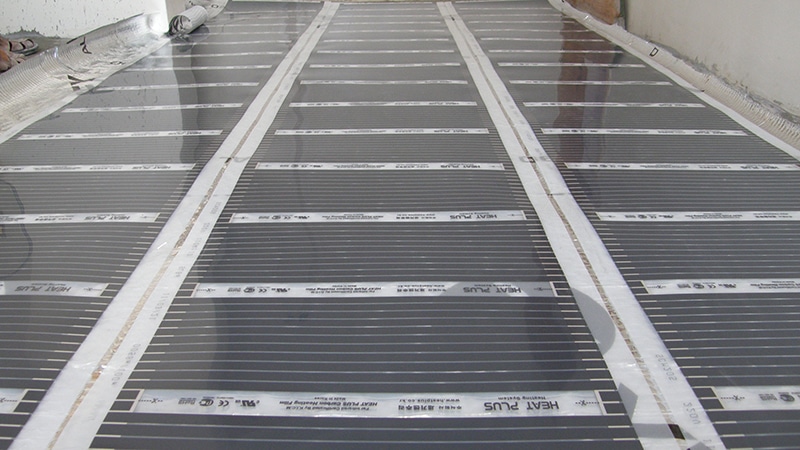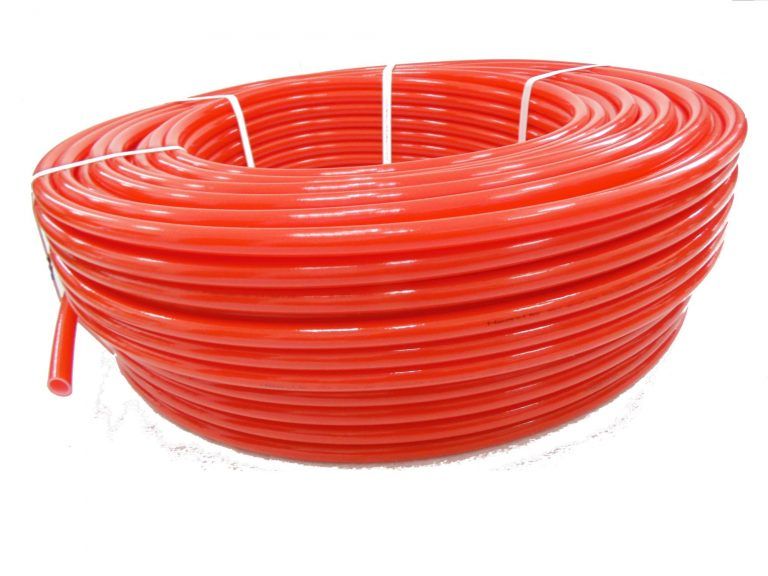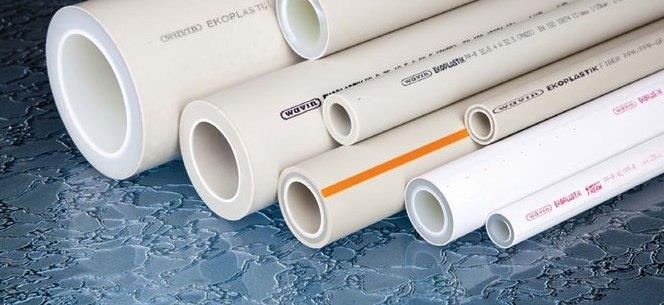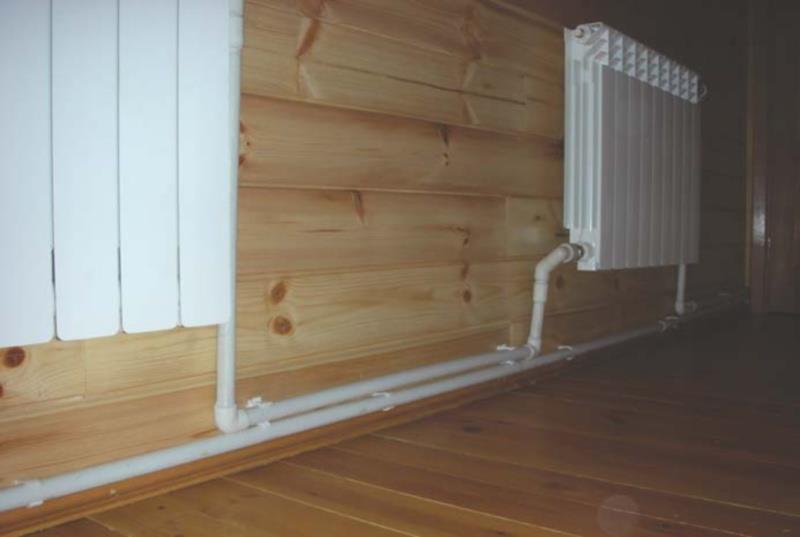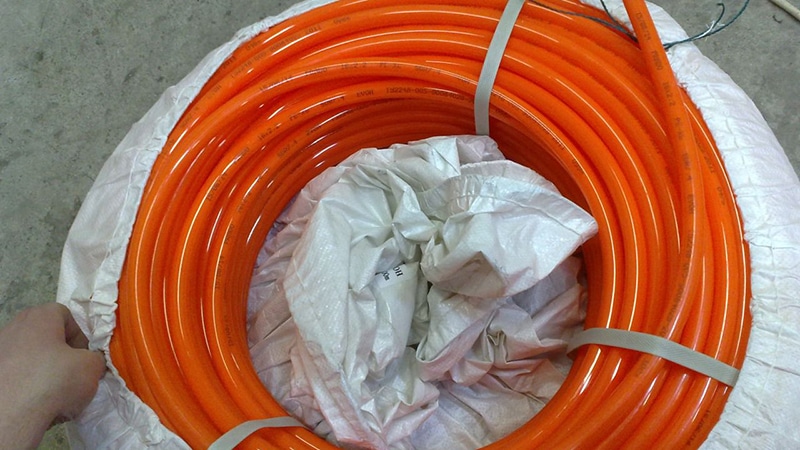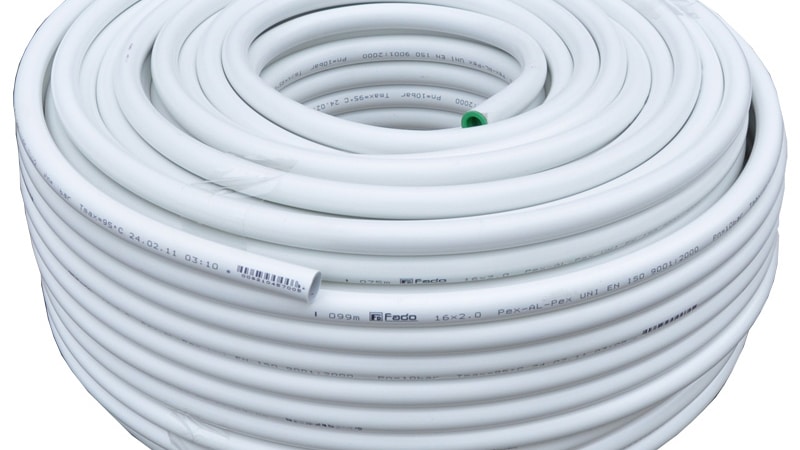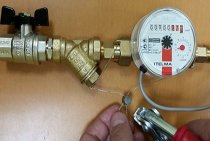In custody
There are no difficulties in the installation of polypropylene pipes. The material is so convenient and practical in work that it allows you to install underfloor heating on your own. Here it is necessary to recall the intricacies of styling. For underfloor heating, it is important to comply with the pipe laying step. When using warm water floors as the main heating, the pipeline should be laid in steps of 12-15 cm. If you want to make floor heating more intense, the pipe laying step should be 30 cm.
In case of emergencies associated with a break in the main heating circuit, repair work is carried out. You can find the place of a breakthrough of a polypropylene pipe using a thermal imager, or using a map - a diagram of laying heating floors. After removing the screed, the damaged area is cut out and replaced with a new fragment. The tightness of the joints is achieved by welding work. Polypropylene pipe in this regard is very convenient and practical.
There is a need for additional floor heating in all regions of our country: the first floors of residential buildings are cooled most of the year. The solution to the problem is the installation of a separate heating system under the screed. Most often, polypropylene pipes are used as a conductor.
Pros and cons of underfloor heating made of polypropylene pipes
Is it worth choosing products for organizing floor heating and can propylene pipes be poured with concrete under the screed?
Let's start with the pros of using the material:
- Resistance to temperature and pressure changes;
- Low thermal conductivity minimizes the loss of thermal energy;
- Low cost of pipes and their installation, maintenance;
- There are no deposits on the inner walls.
- The low flexibility of pipes with at least 8 diameters makes contours difficult";
- The temperature in the room during laying is limited - not lower than + 15 ° C;
- High coefficient of linear expansion - conductors can change their dimensions when exposed to hot water. It is possible to lay polypropylene pipes in the floor screed, but it is necessary to correctly calculate and select them so that there are no internal stresses that can lead to rapid wear.
Contour laying rules
To ensure the efficient operation of this heating system, compliance with the basic rules for laying circuits is required. Their total length should not exceed 80 m. For uniform heating, the optimal length is up to 50 m, the standard diameter is 2 cm.
The calculation of the contour and its step is performed for each individual room, especially if they have different temperature conditions.
Underfloor heating process
Pipe laying can be performed using different schemes:
- spiral;
- double helix;
- snake - loops;
- snail.
The choice of a suitable scheme depends on the parameters of the room and the functional purpose of its zones. For example, a spiral circuit will ensure uniform heating of rooms that have the correct shape, and a snake is more suitable so that the hot coolant first gets into cold zones, and then heats other parts of the room.
Spiral pipe laying
After laying polypropylene pipes, they are fastened with clamps to a metal reinforcing mesh. Then they are connected to the circuits, and the system is filled with water to check for leaks in it. The pressure in the system must be 1.5 times the working pressure, but not less than 6 bar. Further, the pressure is increased to the previous indicator every half hour at least 3 times, and then left for a day. If during this time the pressure does not drop by more than 2 bar, then the laying is done perfectly.
Water floor heating device
To arrange such a floor, it is necessary to lay pipes through which hot water will circulate, the source of which can be central heating or a separate boiler.
One of the most common ways to install underfloor heating is a concrete heating system. All work can be divided into several stages: drawing up a project, preparing the floor, laying the grid and pipes, pouring concrete, laying the finish coating.
Drawing up a project for future work is mandatory, especially if it is planned to insulate floors over a large area. When designing, it should be taken into account what the floors, walls and other elements are made of. This is necessary in order to calculate the desired temperature, which should be in the room. Then you need to determine the installation location of the collector, boiler. After that, it is necessary to draw up a layout of pipes, indicate the length of the circuit and diameter, as well as other parameters.
The temperature of the heating water must be set on the basis of a calculation that takes into account the type of room, the type of flooring and the outside design temperature. As a rule, the maximum temperature level for floor heating is +45 degrees at a water flow rate of 0.3 m / s for smooth heat distribution.
Preparatory work
The collector cabinet is best placed on the wall near the floor
In order for the thermal design of the room to pass according to the rules, it is necessary to start work with the installation of a collector cabinet - the basis of the future warm floor made of polypropylene pipes. It is designed to connect all circuits and the location of the adjustment elements. It is better to place it on the wall near the floor. Hot water supply and return pipes are connected to the cabinet, to which the collector group is connected.
The next step is the laying of waterproofing, which is suitable for polyethylene. It is overlapped and connected with adhesive tape. A damper tape must be glued around the perimeter of the room in which the underfloor heating is being installed. It will prevent cracking of the screed when thermal expansion occurs.
Then the insulation is laid. If this is not done, then heat loss will average 40%. The choice of material depends on the calculations of heat loss during the preparation of the project. Mineral wool, polystyrene, technical cork or other materials can be used as thermal insulation. You can use a special version for the water floor, which is equipped with a reflective surface.
Laying the contours of polypropylene floors
The diameter of the pipe and the laying step will depend on the specific location. In cold places (at the front door, near windows), polypropylene pipes are laid more often; in places where furniture will stand, they do not fit. To fix a warm floor, there are two ways of fastening: to a reinforcing mesh and to thermal insulation.
Reinforcing mesh is a more rational option. It will make it possible to lay polypropylene pipes more evenly. In addition, it will increase the strength of the screed. Pipes are fastened with plastic clamps or wire. To speed up installation, you can use brackets.
It is better to lay the floor from propylene from a roll or reel. This will keep the number of connections to a minimum. This will enable you to save time and money. The pipe is fastened every 80 cm. It is not worth tightening the clamps strongly, otherwise the linear expansion will lead to pipe deformation.
In order for the space to be heated evenly, the length of one circuit should not exceed 80 m. The ideal length is 50 m. All circuits should have approximately the same length. The collector should be selected depending on the number of circuits. For example, if there are 7 circuits, then there should be 7 outputs.
There are several ways to lay polypropylene pipes, from which a warm floor is mounted. With the parallel or serpentine method, the pipe is laid in a zigzag pattern. This method is best suited for a small room.The spiral method ("snail") is used in large rooms. The installation of pipes takes place in a spiral, alternating cold and hot, which allows for better heating.
The standard choice of pipes, taking into account their linear expansion and the required power, is 2 cm in diameter
You should pay attention to the quality of the pipes, since the warm floor is not installed for one year
Polypropylene pipes
And it’s worth starting with the base - polypropylene pipes. They are now known to many, have become an excellent replacement for traditional metal products. At the same time, they can be used in various environments: in mines, canals, under plaster or in the ground. Therefore, this material is well suited for underfloor heating. However, do not forget to take into account the ambient temperature. To install them, the air temperature should not be less than plus five degrees Celsius. Of course, this significantly limits the use of such material.
Such products have a too large bending radius - this is their main drawback. Thus, with a diameter of 16 mm, the product is laid with a minimum distance of 128 mm. This is not always convenient in terms of providing the necessary thermal power.
Pipes are connected using a special welding machine based on a thermal method. If you need to connect polypropylene products with metal ones, then flange and combined parts should be used.
Calculation of a warm "polypropylene" floor
To comply with the maximum temperature of the upper layer of the floor, polypropylene pipes are used - a warm floor is created in the room. At the same time, the water flow rate should be about 0.3 m / s so that the heat spreads smoothly over the heated area.
What determines the temperature of the warm floor:
- on the type of room: kitchen, bathroom, corridor, and so on;
- from the temperature of the room itself;
- from the final coating: carpet, laminate, tile and so on.
Often, an indicator of 45 degrees Celsius is taken as the average parameter.
Pipe calculation
It is impossible to make a warm floor without calculating the entire heating system, taking into account the area of \u200b\u200bthe heated room, the coolant pressure in the riser, and so on. Based on these characteristics, the pipe diameter is calculated.
Often, pipes 25, 20 and 16 mm in diameter are used for underfloor heating.
What are the consequences of making the wrong choice?
If the pipes are installed with a smaller diameter, the circulation of water in the system may be disturbed. To find out the pressure in the system, it is enough to measure it with a hydraulic pressure gauge.
When calculating the diameter of the pipes, you should also deal with their length. When making calculations, remember that the laying of the system starts from the walls with windows, since the cold air must be heated first. And after that, the heat should be distributed throughout the system.
Laying methods
At the design stage, it is necessary to decide on the installation method: “shell” or “snake”.
"Shell" is most often used in our area. Although the design and installation of this method is more difficult than the second. The popularity of this method is due to the uniform distribution of heat over the floor surface. After all, hot supply and return slightly cooled pipes run in parallel. In this case, an average temperature is observed in any heated area, and the heating return point of the coolant is located in the middle of the pipe.
"Snake" can often be found in European homes. It is easier to calculate and install. Although there is no need to talk about the uniformity of heat distribution. As a result, during operation in some areas, the temperature may exceed the norm. Thus, with this method, heat losses increase, and the level of comfort of use decreases. Therefore, it is worth laying pipes with a “snake” if the temperature difference at the inlet and outlet is no more than five degrees.
Installation
According to the standards that must be taken into account when designing, the pipes should be located at a distance of about 20 cm from the walls, and the step is about 40 cm.
For laying the system, it is better to use coils, rather than individual pieces of material, since this will reduce the number of joints, and therefore save money.
In one circuit, the length of the heating element should not exceed 100 m. To release air, a tap is made at the highest point of the system.
Installation of "polypropylene" warm is carried out according to the principle of installing a pipeline. When laying, you need to monitor the material so as not to cause mechanical damage to it with a metal fastener.
Examination
After laying the system, it must be run at half power. Products must take their final form, and then a new layer is installed.
Is the game worth the candle?
Do-it-yourself installation of a warm floor is not difficult if you follow the recommendations given. Additionally, you can find video and photo instructions. All this in the complex will allow you to create a high-quality and evenly heated floor heating that will delight all households and guests in the cold season.
Warm floors under a tile
Tiled floors are durable, they are not afraid of moisture and exposure to aggressive liquids. Therefore, many homeowners opt for an electric warm field followed by tiling.
Tiled warm floor
In addition, they are economical, because they allow you to adjust the temperature according to the season. The device of a warm floor under a tile is made cable, film and in the form of heating mats. Consider their pros and cons.
Cable underfloor heating system
Today, cable underfloor heating under tiles is used infrequently. Due to the high pie of this system, which includes a concrete screed up to 4 cm thick, the height of the room steals and the load on the base increases. Therefore, it is better to use it in rooms without decoration.
Cable floor heating system
Cheaper products include single-core cables. Their use is problematic in rooms with a complex layout, since there is a need for a thermostat. It is easier to lay higher twin-core options, the ends of which do not converge at one point. Such a floor is started after the screed or tile adhesive has completely hardened.
Warm floor from electric mats
This option is suitable for rooms with a concrete base. The mats have a base of thin cables embedded in a reinforced mesh. They are produced with a thickness of no more than 3 mm and do not reduce the height of the premises. The absence of a screed and the minimum thickness of the heating mats make it possible to use such floors in rooms with low ceilings.
Appearance of mats with electric cable for underfloor heating
They are laid directly on concrete, covered with tile adhesive, on which the tiles are fixed. Despite the ease of installation of this heating system, it is much more expensive than a cable counterpart.
Film floor option
Underfloor heating film under the tile is one of the most modern and efficient electrical systems.
Film floor heating
It is easy to install and can be applied to all top coats. The heat carrier in the form of infrared radiation not only has a high efficiency, but is also harmless to health.
Now you know how to make a warm floor from heating with your own hands, and choosing the right option will allow you to independently create not only a reliable heating system, but also save on installation and commissioning.
Polyethylene and polypropylene advantages and disadvantages
Before giving preference to one or another option, let's take a closer look at pipes made of cross-linked polyethylene and polypropylene.
At the word "polyethylene", and even cross-linked, most ordinary people immediately have an image of something fragile and short-lived, but this is by no means the case. Modern technologies make it possible to stitch materials in such a way that no seam remains on the surface of the pipe, which weakens the strength of the structure.
More recently, polyethylene hoses were welded with a longitudinal seam, which did not make them particularly strong. As a result, the most common areas of their use were dachas and household plots, where they were used for watering plantations.
 But polyethylene, cross-linked with the help of modern technologies, has increased strength. This is especially true for the PE-RT polyethylene pipe, that is, with increased heat resistance. The wall structure of such a pipe is a three-dimensional network with strong molecular bonds. This is achieved by the fact that the welding of the pipe takes place at the molecular level, as a result, an almost monolithic joint is formed.
But polyethylene, cross-linked with the help of modern technologies, has increased strength. This is especially true for the PE-RT polyethylene pipe, that is, with increased heat resistance. The wall structure of such a pipe is a three-dimensional network with strong molecular bonds. This is achieved by the fact that the welding of the pipe takes place at the molecular level, as a result, an almost monolithic joint is formed.
 Among the disadvantages of polyethylene underfloor heating, one can note their insufficient resistance to external physical influences.
Among the disadvantages of polyethylene underfloor heating, one can note their insufficient resistance to external physical influences.
External pressure can pinch the pipe, which will lead to problems with the circulation of the coolant through the system, so it is recommended to cover polyethylene heating elements with a concrete screed, which plays the role of a kind of shell that protects them from pressure from the floor covering.
Polypropylene
 Pipes made from this material are known to almost everyone today. Over the past decade, they have almost supplanted the “classics” in the form of metal water pipes in construction.
Pipes made from this material are known to almost everyone today. Over the past decade, they have almost supplanted the “classics” in the form of metal water pipes in construction.
Polypropylene pipes have a whole range of undeniable advantages:

They have heating systems and their drawbacks. First of all, these are restrictions in loads, which are 7.5 atmospheres of pressure and + 95 C maximum temperature. The recommended operating temperature is +75 C.

When these parameters are exceeded, polypropylene begins to deform and significantly increase in volume. Another disadvantage of such pipes is excessive rigidity.
It is unlikely that it will be possible to lay polypropylene with a “snake” or a spiral, like polyethylene pipes, therefore, when installing a warm floor made of polypropylene, it will be impossible to do without an “iron” for welding pipes and corner adapters for connecting individual elements.
 After getting acquainted with all the advantages and disadvantages of polypropylene and polyethylene, you will be able to make the most suitable choice for you.
After getting acquainted with all the advantages and disadvantages of polypropylene and polyethylene, you will be able to make the most suitable choice for you.
If you decide to use polypropylene pipes as a material for underfloor heating, you should familiarize yourself with the main criteria for their selection.
Advantages of polypropylene pipes
The benefits of these products include:
-
Durability
- subject to the basic rules for operating the system, as well as the temperature regime in it up to 75 degrees, the products can last more than 25 years. -
Seam tightness
is ensured by the use of a special technology for connecting the individual components of the pipeline using a soldering iron. -
Elasticity
, high mechanical strength and frost resistance. Even if the transported liquid freezes, the products expand slightly and then return to their original dimensions. -
Not susceptible to corrosion
, are not afraid of exposure to solvents and acids, salt deposits on internal surfaces. -
Absence
in them bacterial flora
. -
Low thermal conductivity
and the absence of condensate are due to the same temperature of the coolant at the inlet and outlet of the system. -
low cost
pipes and connecting elements in comparison with alternative options. High environmental performance of the material allows not to harm the environment during its operation and disposal. -
light weight
compared to steel products.
Polypropylene pipes used for underfloor heating are exposed to high temperatures and change their dimensions. Usually, the coefficients of thermal and linear expansion are fixed in their characteristics. Therefore, experts recommend during installation to give preference to products reinforced with fiberglass or aluminum.
A few words about polypropylene pipes
Polypropylene pipes are used quite widely in engineering systems for various purposes: water supply, heating. They are suitable for laying in the ground, in channels, in shafts, in walls under plaster or in open form. Their main advantage is in the way they are connected to each other, when the pipes after thermal welding turn into a monolith. For this, special equipment is used - a welding machine, which is popularly called a soldering iron. Using it is quite simple, soldering takes only a few minutes.
Use a special soldering iron, then the pipes after thermal welding turn into a monolith.
Other advantages of these pipes are high mechanical strength and resistance to defrosting. Even if water freezes in the pipe, nothing threatens its integrity. It will expand and, after it thaws, will take its original shape.
At an operating temperature of pipes plus 75 degrees and a pressure of 7.5 atmospheres, they are guaranteed to last at least 25 years. The highest temperature they can withstand is plus 95 degrees, but then their service life will decrease.
The use of polypropylene pipes for underfloor heating is economically beneficial, because they are much cheaper than any other, for example, metal-plastic ones. This is especially true for connecting parts.
The choice of polypropylene pipes
Main types
Polypropylene pipes are made from various types of polypropylene. You can determine what kind of product by marking:
- The pp type pipe is made of thermoplastic. Therefore, such pipes can be welded. They have sufficient rigidity and are connected by fittings by means of permanent connections. Such a pipe is able to withstand an operating temperature of 70 degrees C and has a diameter of 16 to 125 mm.
Polypropylene pipes with markings applied to them to identify the type
- Polypropylene pipe pph type is made from homopropylene. These pipes are suitable for:
- for ventilation lines;
- for installation of cold water supply;
- for industrial pipelines.
- ppb type pipes are made from a block copolymer. They are best used to install central and autonomous heating in the house. They are suitable for both underfloor heating and cold water supply.
- Prr type pipes are characterized by increased heat resistance, strength and shape stability. They are used to supply cold and hot water, in heating systems. They are able to withstand temperatures up to 95 degrees C. You can be sure that this type of polypropylene pipe does not flow even in case of very high mechanical stress.
Fundamental rules
When installing polypropylene pipes, it is necessary to correctly connect them to each other. Connect the segments of polypropylene pipes using fittings. Today, such products are presented in a large assortment. With their help, installation takes very little time. The pipe is cut using special tools and the subsequent connection of the segments through fittings.
You can also use soldering pipes. This method of connection takes a little longer than connection with fittings, but the connection itself is more reliable and tight.
Connection of polypropylene pipes
Polypropylene pipes are connected using a special soldering iron. This is a cheap tool that you can not only buy, but also rent today. It does not require special professional skills and is easy to use.
The only thing to remember when working with it is that during welding, the diameter of the polymer pipe should not change. To do this, do not overheat the pipe or fitting during soldering. Especially carefully it is required to connect pipes of large diameter.
In order to avoid melting a polypropylene pipe, you need to conduct a simple test: blow into it. If the air goes well, then the connection went well. If you have to apply some effort, blowing into the pipe, then the pipe has melted.
Features of the use of polypropylene pipes for the heating system
Polypropylene pipes are suitable not only for hot and cold water supply. They can also be installed on a central or autonomous heating system. They can significantly reduce the cost of installation work when replacing an old heating system. After all, metal pipes themselves cost no more than 30% of the total cost of replacing an old heating system. The rest of the money goes to the salaries of welders and assemblers.
When replacing an old heating system, installing polypropylene pipes will be the most economical repair option. Therefore, if you decide to repair the heating system in your house on your own, then it is best to use polypropylene. For installation, you will need the pipes themselves, a special soldering iron and a little patience and accuracy on your part. It should be noted that the replacement of metal pipes with polypropylene ones will be carried out as soon as possible.
Professional installation of polypropylene pipes
Using Other Alternatives
Today, in addition to polypropylene, other types of inexpensive materials are used for heating systems, the quality of their work largely depends on the correct choice of which. For example, a cost-effective option for underfloor heating may be polyethylene pipes, which have excellent thermal conductivity and wear resistance.
Polyethylene pipes
They, unlike the propylene counterpart, are less susceptible to expansion under the influence of sufficiently high temperatures. When installing pipes made of cross-linked polyethylene, they need to be rigidly fixed, otherwise they can straighten out, which is one of their main drawbacks.
Metal-plastic pipes are also in great demand, thanks to the inner aluminum layer they have good thermal conductivity, and polymer layers ensure their resistance to damage. Their small disadvantage is the internal formation of scale in the places of threaded connections of fittings and a higher cost compared to propylene counterparts.
Metal pipes for underfloor heating
Pipe marking and the right choice
The marking of polypropylene pipes is the first thing that they pay attention to when choosing a suitable conductor for hot water, since not every product is suitable for this purpose. What is hidden under the ciphers:
- Operating pressure PN, which the pipe must withstand during its entire service life at a water temperature of 20°C. For a warm floor, you should choose a designation not lower than PN20-25 - they are designed for hot water.
- Variety of material: PP - polypropylene. Its addition PP-1, PP-2, PPB indicates the type of raw material used - homopolymer or block copolymer. For hot water, pipes marked PPR, sometimes PPB, are suitable.
- The diameter of the conductors and the thickness of their walls in millimeters from 10 to 1200 mm. For internal heating systems and the organization of a warm floor, pipes with an internal diameter of not more than 30 mm are used.
- Marking - designation of the manufacturer, year of manufacture.
